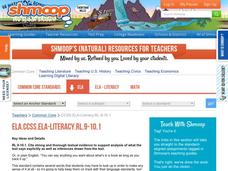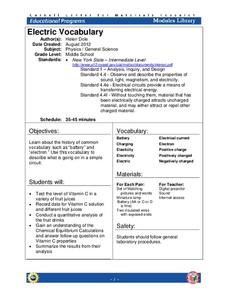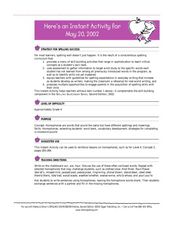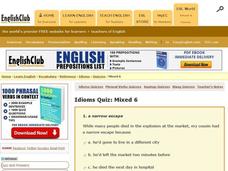Shmoop
ELA.CCSS.ELA-Literacy.RL.9-10.1
Does your ELA class need some practice with the specific skills outlined in the Common Core standards? Then this is the perfect resource for you! One in a series of connected lessons that cover the standards for reading literature,...
Curriculum Corner
“I Can” Common Core! 1st Grade Math
Any first grader can master the Common Core math standards with this checklist! With each standard rewritten as an affirmative I can statement, children are provide with clear goals to work toward throughout the school...
John Wiley & Sons
Defining Leadership
Learners use their experience with leadership, as well as a thought-provoking quote and discussion with their classmates, to help them define the concept of leadership.
Cornell University
Electric Vocabulary
Practice electric vocabulary using multiple methods. Learners begin by watching a video that explains vocabulary related to electric currents. They match vocabulary cards to practice and then create an electric circuit. Using the...
Curated OER
Hunt the Fact Monster Hunt #22
For this internet research worksheet, students use the internet to answer ten questions. Six of the questions are multiple choice, four are short answer questions.
TED-Ed
Different Ways of Knowing
“Words have colors, emotions, numbers, shapes, and personalities.” Daniel Tammet welcomes viewers to his world with a 10-minutes video that illustrates how he, as an autistic savant, perceives the world. Class members are then...
Education Development Center
Rational Exponents
It's rational to root for your class to learn about exponents. Scholars study rational exponents by reading a fictional dialogue between classmates. They analyze the conversation to understand the connection between rational exponents...
Curated OER
Sentence Completion 19
Help your English language learners deduce meaning from context clues. Eight multiple-choice questions are provided here; each one has five answer options. Example vocabulary words include refused, absent, and original.
Curated OER
The Landlady Pre-Reading: The Characters
Prepare your class to read "The Landlady" by Roald Dahl with these pre-reading activities about the two main characters in the story. This resource provides a brief overview of the story as well as excerpts from the text that describe...
Curated OER
Ordinary People: Cubing Strategy
Readers of Ordinary People employ a cubing strategy based on Bloom’s Taxonomy to analyze, from multiple perspectives, an excerpt from Chapter 10 of Judith Guest’s novel. The excerpt, a rationale and complete directions for the...
Curated OER
Proofreading: Lesson 2
Identify and develop strategies for proofreading with your class. They read and identify the grammar rules for capitalization, end punctuation, and commas, correct errors as a class, and complete three worksheets. This resource includes...
Curated OER
Internet Fact Hunt at the "Fact Monster" Web Site- Hunt #35
In this Internet fact hunt worksheet, learners access the "Fact Monster" web site to find the answers to 5 multiple choice questions. They answer questions about Canada, using e-mail, inventions, and Ecuador.
Curated OER
Review of Diction
In this online interactive diction worksheet, students choose which multiple choice answer best answers 11 questions concerning diction in grammar sentences.
Curated OER
Landmark Supreme Court Cases And The Constitution
Have an engaging class discussion on the Bill of Rights, U.S. Constitution, and the Supreme Court. Learners examine multiple aspects of the Marbury v. Madison case and the impact that case had on the judicial system in the U.S. Web...
Curated OER
Academic Raceway: Animals
Race to the finish line with this interactive PowerPoint! Students must answer multiple choice questions about animals to get to the Winners' Circle. Tip: Have students play individually until they can get all of the questions correct.
Curated OER
Literature and the Language Arts
Reading involves more than simply picking up a text and saying the words aloud. A practice guide introduces readers to key skills such as making inferences, finding the main idea or theme, and using context clues. Each skill contains a...
Personal Genetics Education Project
Engineering the World Around Us: Genome Editing and the Environment
Challenge young minds to build a better world with genetic engineering. Biologists learn potential solutions for environmental issues using genome editing while interacting with three case studies. Scholars read articles and view...
Curated OER
Statistics: Final Exam Review
For this statistics and probability worksheet, students are provided with a review of the final exam in statistics. The three page worksheet contains a combination of six multiple choice and free response questions. Answers...
Curated OER
Homophone Practice
Fourth graders practice their spelling skills by completing a spelling homophone activity. In this homophone lesson, 4th graders discuss easily-confused word spellings. Students write sentences using homophones. Students complete the...
Curated OER
Spooky Story
Second graders write a Halloween story. In this combined technology and writing lesson, 2nd graders create a Halloween picture using KidPix, insert it into Microsoft Word, and then write a story to correspond with the picture.
Curated OER
Teenagers and cleaning
In this teenagers and cleaning worksheet, students choose the correct word to complete the sentences about teenagers and cleaning. Students complete 10 multiple choice questions.
Curated OER
Idioms Quiz: Mixed 6
In this idioms quiz learning exercise, students complete multiple choice questions where they choose what the idioms means. Students complete 10 problems total.
Curated OER
Parts of Speech: articles
In this articles worksheet, students read about the part of speech that indicates an article, and have a multiple choice quiz on articles. Students answer 10 questions.
Curated OER
Persian War Defeated and Persepolis Goes Up In Flames
In this Persian War and Persepolis worksheet, students read 2 passages about each and then answer short answer, multiple choice, and matching questions. Students answer 14 questions each.

























